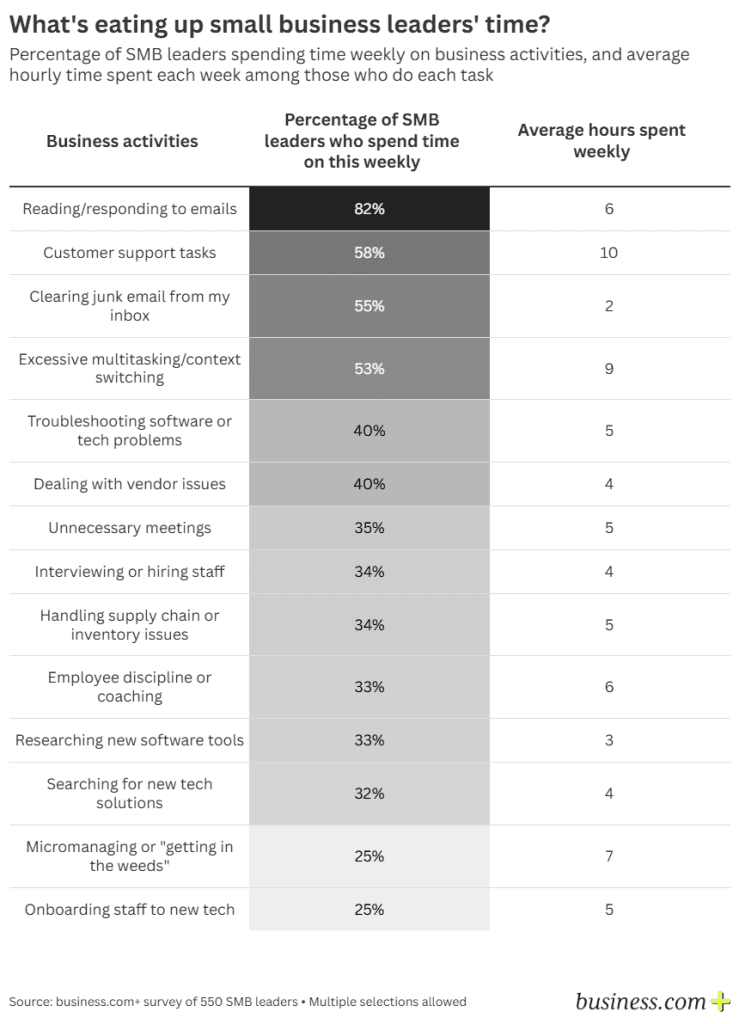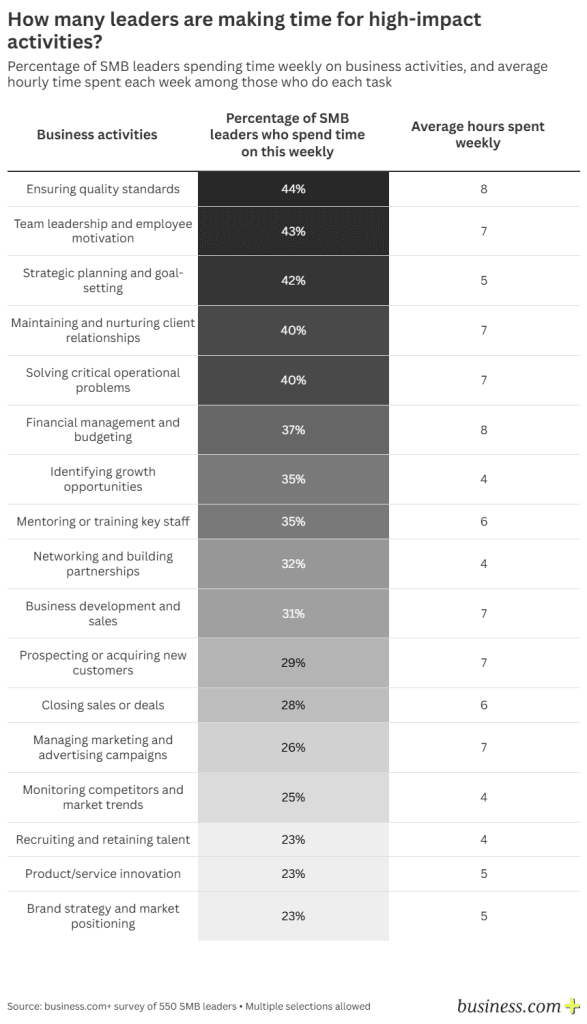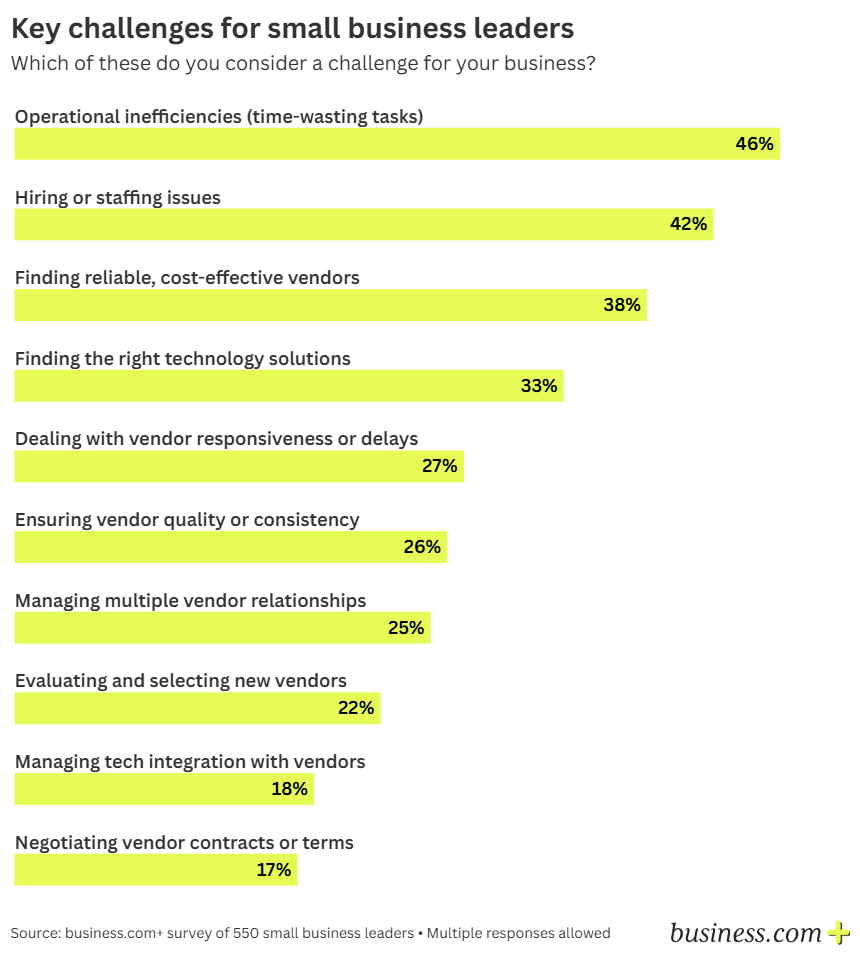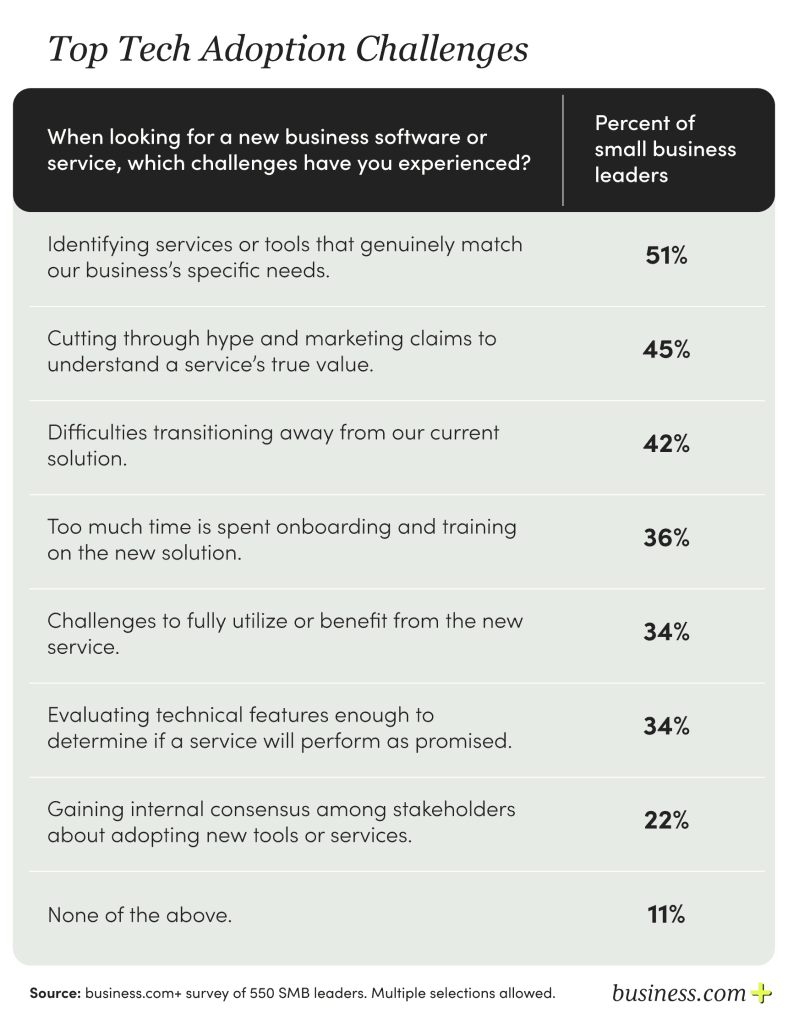Business.com aims to help business owners make informed decisions to support and grow their companies. We research and recommend products and services suitable for various business types, investing thousands of hours each year in this process.
As a business, we need to generate revenue to sustain our content. We have financial relationships with some companies we cover, earning commissions when readers purchase from our partners or share information about their needs. These relationships do not dictate our advice and recommendations. Our editorial team independently evaluates and recommends products and services based on their research and expertise. Learn more about our process and partners here.
Time Trapped: The Productivity Crisis Facing Small Business Leaders
A new study of small business leaders shows they spend more time wrestling with operational inefficiencies than pursuing growth opportunities each week.

Table of Contents
Over 33 million small businesses exist in the U.S., making up 99.9 percent of all businesses that power the economy. Together, they employ more than 60 million people, nearly half the private-sector workforce.
While their impact is significant, many small business leaders operate with extremely limited resources. Without the luxury of large teams or dedicated departments, they often juggle operations, problem-solving and decision-making while trying to grow their business. While full of potential, AI hasn’t solved this problem for business leaders.
To better understand how these demands impact productivity, business.com conducted a study of small business founders and senior leaders. The findings show where small business leaders spend their time, where some of it goes to waste and what they want to delegate to focus on growth.
Here are the key hurdles to growth, according to our research:
- Strategic-operational disconnect: While 41% of leaders want to increase the time spent on growth opportunities, only 35% actually devote time to it weekly, averaging just four hours a week on growth. This fundamental misalignment between priorities and time allocation is hampering small business growth.
- Operational inefficiencies: 46% of leaders cite operational inefficiencies as a core challenge. It consumes 6.6 hours of leadership time weekly that could be directed toward strategic growth.
- Leaders consumed by low-ROI tasks: Small business leaders lose nearly a full workday (nine hours weekly) to excessive multitasking and context switching. One in four admit to micromanaging their teams, spending twice as much time each week micromanaging as they do on strategic growth.
- Talent acquisition hurdles: Hiring challenges are a top concern for 24% of leaders. 80% of small businesses are understaffed by an average of five employees, particularly in growth-driving roles like sales, IT and marketing.
- Tech decision fatigue: Despite recognizing their need, 51% of leaders struggle to identify suitable technology solutions, and 42% face difficulties transitioning from outdated systems. This “decision paralysis” prevents technological advancement and hampers productivity.
What’s Draining Leaders’ Time?
Small businesses have had many hurdles to overcome over the past few years, not least the impact of sky-high inflation and political changes. However, one of the greatest problems small business leaders face is deciding how to spend their average 45 hours at work each week. Unfortunately, our research reveals that too many leaders are sucked into low-impact tasks that don’t help them reach their business goals.
During a typical workweek, small business leaders reported spending time on the following activities.

The burden of digital communications tops the list of time drainers for small business leaders. While one in two small business owners state that digital technology enabled them to start their business, too many get bogged down by keeping up with the tools. According to our data, 82 percent of leaders spend up to eight hours each week in email management, including reading and responding to emails and clearing out junk mail. That’s the equivalent of a full working day!
With 85 percent of small businesses having fewer than 20 employees, it’s unsurprising that many lack a dedicated IT department. For this reason, small business leaders also get pulled into typical tasks like:
- Troubleshooting tech (five hours each week)
- Researching new software (three hours)
- Searching for tech solutions (four hours weekly).
- IT and HR functions, such as onboarding staff to new systems (up to five hours weekly)
Worse, they may be taking on work they don’t need to: one in four small business leaders admit to micromanaging their teams rather than empowering them to work independently. In fact, micromanaging eats up seven hours weekly – more time than leaders spend on networking, building partnerships or identifying growth opportunities (four hours on average).

Leaders can easily fall into the trap of mistaking busy for productive, but constant multitasking and reactive work habits can easily erode their focus. Our data shows that 53 percent of leaders excessively context switch, which wastes a staggering nine hours of work each week.
Low-value meetings are another problem area—our research reveals that one in three leaders spends at least five hours each week, or 20 hours a month, attending “unnecessary meetings.”
Leaders’ Time Aspirations vs. Reality
Small business leaders are short on time but not on strategic ambition. When asked where they would ideally dedicate more of their focus, the answers point overwhelmingly toward growth. Identifying new opportunities was the top priority, cited by 41 percent of respondents, followed closely by strategic planning and goal-setting (38 percent) and acquiring new customers (35 percent).

Top five activities small business leaders want to spend more time on
- Ensuring quality standards
- Team leadership and employee motivation
- Strategic planning and goal-setting
- Maintaining and nurturing client relationships
- Solving critical operational problems
Other areas like innovation, relationship management, mentoring and partnership-building were also flagged as necessary but underfunded with time. So, what’s going wrong?
Operational demands dominate the work week
Despite these intentions, most leaders are consumed by operational demands. Nearly half want to spend less time on recruiting and retaining staff (49 percent), solving operational problems (49 percent) and managing financial tasks (48 percent). Yet, those are precisely the areas absorbing the bulk of their attention. Financial management alone takes up 7.8 hours each week, while solving operational issues accounts for 6.6 hours. Quality control, another area not often associated with strategic value, consumes eight hours per week despite 30 percent of leaders wanting to reduce their involvement.
Clear misalignment exists between time and priorities
The gap between aspiration and reality is especially apparent in the numbers. While 41 percent of leaders want to focus more on growth opportunities, only 35 percent are able to. Even then, the average time spent is just 4.3 hours per week. Similarly, 34 percent want to prioritize product or service innovation, but only 23 percent make time for it. These structural indicators prove leaders are consistently pulled away from the work that drives long-term business health.
Leaders fall into the urgency trap
The result is a leadership model shaped by urgency rather than importance. The day-to-day realities of staffing gaps, operational inefficiencies and the complexity of adopting better solutions make it difficult to implement lasting change. And this disconnect between intent and execution is the defining leadership challenge for today’s small business owners.
According to Greg Stirling, the co-founder of Dialog, a business research firm, distinguishing between high-priority tasks and low-value distractions is a leadership skill that must be developed over time. “Leaders must learn to delegate non-essential decisions and tasks to others. That requires discipline and restraint. They must also learn to distinguish between strategic activities that absolutely require their attention and those that can be carried out by trusted subordinates,” Stirling said. “There’s no magic solution or ‘easy button’ here. This is all about trial and error and learning from past mistakes.”
Root Causes of the Leadership Time Crisis
Behind the daily distractions and endless task lists lie deeper systemic issues that small business leaders themselves identify as the most significant barriers to progress. Leaders contend with structural and operational challenges that are harder to solve and far more draining in the long term.

1. Operational gaps are a primary pain point
Forty-six percent of small business leaders cite operational inefficiencies as a core challenge and more than a quarter say it’s their single most significant issue. Whether process bottlenecks, outdated tech systems or poor internal coordination, these inefficiencies directly drain leadership bandwidth, often without a clear path to resolution.
2. Talent challenges hold businesses back
Right behind operational friction is a people problem. Forty-two percent of leaders face hiring and staffing challenges, and 24 percent rank them as their top concern. The reality is that many small businesses are running lean: We found that only 20 percent are fully staffed; the rest say they need an extra five employees on average. Being chronically short-staffed prevents leaders from delegating tasks that are draining their focus.
Among our respondents, the most significant hiring gaps are in leadership, sales and customer service, IT and tech and marketing and creative – key functions for driving growth. Unfortunately, 68 percent say finding qualified workers is a major challenge, and over 53 percent believe their staffing issues are holding back business growth.

Why the struggle? According to Goldman Sachs research, small businesses point to fierce competition with larger employers on pay and benefits (62 percent), a shallow talent pool (53 percent) and high labor costs (52 percent), making it challenging to attract the right people even when they’re ready to grow.
Being short-staffed is preventing leaders from being able to effectively delegate. As a result, their focus is fractured. According to our data, leaders are responsible for an extremely wide variety of functions:
- 39 percent are responsible for website updates
- 30 percent manage digital ad campaigns each week
- 43 percent of leaders handle social media marketing personally
- 39 percent regularly deal with financial management issues such as cash flow or expense oversight.
3. External partners create internal friction
Leaders also struggle to muster the time and energy required to manage vendor relationships. Nearly 40 percent struggle to find reliable, cost-effective vendors. Once they have secured vendors, their issues continue: 27 percent are frustrated by poor vendor responsiveness and 26 percent have had quality issues. Juggling multiple vendor relationships simultaneously also requires finesse, but about one in four leaders say this challenge consumes an average of seven hours per week.
Technology: From Solution to Source of Stress
Among the most time-consuming and mentally exhausting vendor relationships are those tied to technology. From choosing software platforms to managing IT providers, tech-related decisions create unique challenges for small businesses.
One in three small business leaders say finding the right tech solutions is a major challenge and for nearly one in ten, it’s their top concern. Technology typically saves time, but selecting and adopting the right tools requires time and effort.

The psychology behind tech decisions depleting mental bandwidth
Tech decisions tend to be complex, impacting operations, staffing and finances. As a result, leaders face significant cognitive overload and emotional fatigue as they go through this high-stakes decision-making process. Here’s how it plays out:
- Decision paralysis: With so many tools on the market and limited time to evaluate them, 51 percent of leaders struggle to identify solutions that fit their business needs. This aligns with classic decision fatigue research: when presented with too many options, people may avoid making a selection or commit to something unsuitable on impulse.
- Transition anxiety: Even when a better option is available, 42 percent of leaders report difficulties transitioning away from existing systems. Switching tech means change, disruption and more decisions, which fatigued leaders are primed to avoid, preferring a “better the devil you know” approach.
- Marketing mistrust: 45 percent of leaders say it’s difficult to cut through marketing hype and 34 percent struggle to evaluate features clearly. Decision fatigue also increases our reliance on cognitive shortcuts, so leaders may rely on brand recognition and peer recommendations or default to doing nothing at all.
- Post-decision burnout: The fatigue doesn’t end once a tool is chosen. 36 percent report onboarding challenges and 34 percent struggle to realize the full benefits. This results in what behavioral experts call “choice regret,” discouraging future innovation or experimentation.
Over time, these compounding effects cause leaders to avoid critical tech upgrades because they’re mentally tapped out from trying to fix them.
Three Mindset Shifts for Efficient Leadership
The data shows that small business leaders are trapped in a cycle of reactive management that prevents them from driving the strategic growth their businesses desperately need. Only 35 percent of leaders dedicate time each week to strategic growth and then for an average of only four hours per week. The gap between intention and execution has become a defining characteristic of small business leadership today.
Perhaps most concerning is how technology, which should be liberating small businesses, has become another source of decision fatigue. With 51 percent of leaders struggling to identify suitable tech solutions and 42 percent unable to transition from outdated systems, the tools meant to create efficiency instead create paralysis.
This technological burden extends beyond selection into daily operations, where leaders spend up to eight hours weekly just managing email communications. The irony is unmistakable: the innovations that enabled many of these businesses to launch are now consuming the bandwidth needed to scale them.
The solution isn’t about working harder or finding more hours in the day. It requires a fundamental shift in how small business leaders approach their role and responsibilities. To scale their ventures, small business leaders can embrace three principles, explained by successful founders:
- Ruthless prioritization and fierce time protection: Leaders must distinguish between tasks that require their unique expertise and those that simply need to be done. “Delegation isn’t about handing things off perfectly. It’s about creating space to lead better and focus on what only you can do,” said Corina Riviere, founder and CEO of an executive staffing agency.
She also stressed the need to carefully guard her time for maximum growth. “One of the most important shifts I’ve made is protecting focused time in my calendar for growth work—usually in the mornings. I block time specifically for things like strategy or system building, and I protect that time fiercely,” Riviere explained.
Every leader is different, though, and should block their time in ways that suit their working style. Innovative femtech company founder and CEO Amanda Miah sets aside a larger time block quarterly for a vision-casting retreat. “Once a quarter, I take a full weekend completely offline—no daily tasks, no email, just me and a notebook thinking about where we want to go and which channels deserve our limited resources, she said. “This helps me zoom out from the day-to-day craziness and remember what actually moves the needle – versus what just feels important in the moment.”
- Systematic delegation: The data shows leaders are willing to delegate many tasks—from SEO optimization to bookkeeping—but struggle with the upfront investment required to make delegation successful. Megan Human Mitchell, the founder and CEO of a rapidly growing marketing agency, discovered how to weave delegation into her company’s culture and processes from the start.
“When we’re teaching the team to prioritize delegation, we always frame it in terms that will matter to them, not just for the business. For instance, we focus on how delegation and clearly documented processes make it easier to take PTO in peace rather than why it’s important for business stability, although it is,” Mitchell explained.
Her team also relies on tech tools to facilitate systematic delegation. “Each week during our team calls, one person trains the rest of the team on a task that only they know how to do. These calls are recorded so that they can easily be turned into standard operating procedures through tools like Scribe,” she added.
- Strategic technology adoption: Rather than avoiding tech decisions due to fatigue, leaders need frameworks for making these choices efficiently. This might mean conducting regular audits of what tech tools the team actually likes and uses, establishing clear evaluation criteria or accepting that “good enough” technology implemented quickly often outperforms perfect solutions that never get deployed.
Emerging solutions like agentic AI can handle routine decisions and research, while expert consultations or personalized recommendations from small business advisors can cut through decision fatigue by providing tailored guidance based on specific needs.
Small businesses don’t have the luxury of inefficiency. Representing 99.9% of all U.S. businesses and employing nearly half the private-sector workforce, their collective health directly impacts economic vitality. When small business leaders are trapped managing operational details instead of driving growth, the ripple effects extend far beyond individual companies.
The small business leaders who will thrive in the coming years won’t be those who can juggle the most tasks or work the longest hours. They’ll be the ones who learn to step back from the operational urgency trap and reclaim their role as strategic drivers of growth.
Our data
In March 2025, business.com+ conducted a web-based poll of 550 small to medium-sized business leaders. The survey was a combination of multiple-choice and open-text responses. These leaders worked as senior managers, directors or C-suite roles in companies with 5 to 249 employees. Sixty-two percent of respondents represented companies with between five and 50 employees, and 38 percent worked in companies with 51-249 employees.
The average annual gross revenue for the businesses represented was $26 million. Participants ranged in age from 18 to 83, with a median age of 39. Participants were 48 percent female and 52 percent male. The ethnic identity of our group was 63 percent white, 20 percent black, 4 percent Asian, and 13 percent mixed or other ethnicities.
